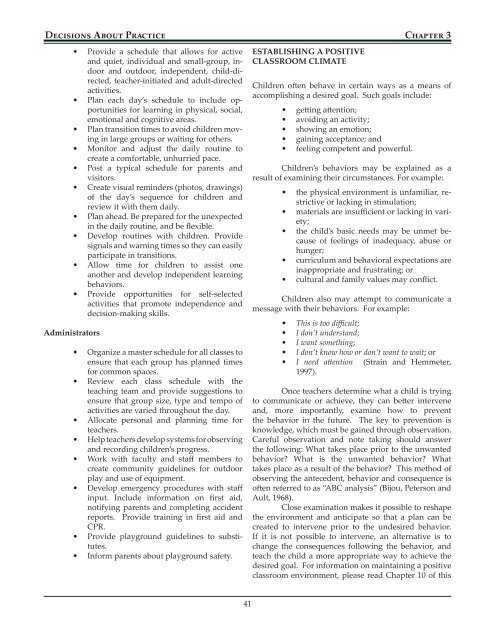Early Childhood - Connecticut State Department of Education
Early Childhood - Connecticut State Department of Education
Early Childhood - Connecticut State Department of Education
You also want an ePaper? Increase the reach of your titles
YUMPU automatically turns print PDFs into web optimized ePapers that Google loves.
Decisions About Practice Chapter 3<br />
• Provide a schedule that allows for active<br />
and quiet, individual and small-group, indoor<br />
and outdoor, independent, child-directed,<br />
teacher-initiated and adult-directed<br />
activities.<br />
• Plan each day’s schedule to include opportunities<br />
for learning in physical, social,<br />
emotional and cognitive areas.<br />
• Plan transition times to avoid children moving<br />
in large groups or waiting for others.<br />
• Monitor and adjust the daily routine to<br />
create a comfortable, unhurried pace.<br />
• Post a typical schedule for parents and<br />
visitors.<br />
• Create visual reminders (photos, drawings)<br />
<strong>of</strong> the day’s sequence for children and<br />
review it with them daily.<br />
• Plan ahead. Be prepared for the unexpected<br />
in the daily routine, and be flexible.<br />
• Develop routines with children. Provide<br />
signals and warning times so they can easily<br />
participate in transitions.<br />
• Allow time for children to assist one<br />
another and develop independent learning<br />
behaviors.<br />
• Provide opportunities for self-selected<br />
activities that promote independence and<br />
decision-making skills.<br />
Administrators<br />
• Organize a master schedule for all classes to<br />
ensure that each group has planned times<br />
for common spaces.<br />
• Review each class schedule with the<br />
teaching team and provide suggestions to<br />
ensure that group size, type and tempo <strong>of</strong><br />
activities are varied throughout the day.<br />
• Allocate personal and planning time for<br />
teachers.<br />
• Help teachers develop systems for observing<br />
and recording children’s progress.<br />
• Work with faculty and staff members to<br />
create community guidelines for outdoor<br />
play and use <strong>of</strong> equipment.<br />
• Develop emergency procedures with staff<br />
input. Include information on first aid,<br />
notifying parents and completing accident<br />
reports. Provide training in first aid and<br />
CPR.<br />
• Provide playground guidelines to substitutes.<br />
• Inform parents about playground safety.<br />
41<br />
ESTABLISHING A POSITIVE<br />
CLASSROOM CLIMATE<br />
Children <strong>of</strong>ten behave in certain ways as a means <strong>of</strong><br />
accomplishing a desired goal. Such goals include:<br />
• getting attention;<br />
• avoiding an activity;<br />
• showing an emotion;<br />
• gaining acceptance; and<br />
• feeling competent and powerful.<br />
Children’s behaviors may be explained as a<br />
result <strong>of</strong> examining their circumstances. For example:<br />
• the physical environment is unfamiliar, restrictive<br />
or lacking in stimulation;<br />
• materials are insufficient or lacking in variety;<br />
• the child’s basic needs may be unmet because<br />
<strong>of</strong> feelings <strong>of</strong> inadequacy, abuse or<br />
hunger;<br />
• curriculum and behavioral expectations are<br />
inappropriate and frustrating; or<br />
• cultural and family values may conflict.<br />
Children also may attempt to communicate a<br />
message with their behaviors. For example:<br />
• This is too difficult;<br />
• I don’t understand;<br />
• I want something;<br />
• I don’t know how or don’t want to wait; or<br />
• I need attention (Strain and Hemmeter,<br />
1997).<br />
Once teachers determine what a child is trying<br />
to communicate or achieve, they can better intervene<br />
and, more importantly, examine how to prevent<br />
the behavior in the future. The key to prevention is<br />
knowledge, which must be gained through observation.<br />
Careful observation and note taking should answer<br />
the following: What takes place prior to the unwanted<br />
behavior? What is the unwanted behavior? What<br />
takes place as a result <strong>of</strong> the behavior? This method <strong>of</strong><br />
observing the antecedent, behavior and consequence is<br />
<strong>of</strong>ten referred to as “ABC analysis” (Bijou, Peterson and<br />
Ault, 1968).<br />
Close examination makes it possible to reshape<br />
the environment and anticipate so that a plan can be<br />
created to intervene prior to the undesired behavior.<br />
If it is not possible to intervene, an alternative is to<br />
change the consequences following the behavior, and<br />
teach the child a more appropriate way to achieve the<br />
desired goal. For information on maintaining a positive<br />
classroom environment, please read Chapter 10 <strong>of</strong> this

















